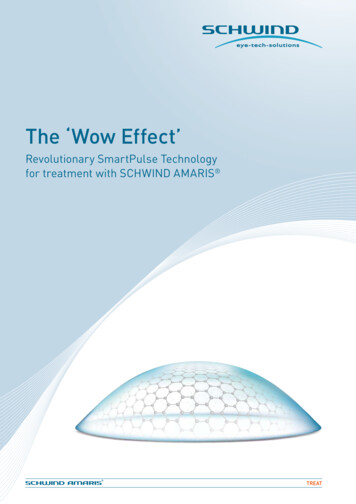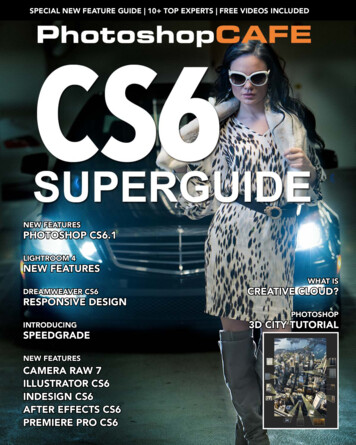
Transcription
The ‘Wow Effect’Revolutionary SmartPulse Technologyfor treatment with SCHWIND AMARIS
The ‘Wow Effect’ immediately aftertreatment with SCHWIND AMARIS Revolutionary SmartPulse TechnologyThe graphic shows local deviations in microns in the 3 to 6mm diameter area. The corneais significantly smoother withSmartPulse. Over the entiresurface, roughness declinesfrom about one pulse (0.75 µm)to a third of a pulse (0.25 µm).Local Standard Deviation (µm)The ‘Wow Effect’ in the earlypostoperative phaseThe new SmartPulse Technology usedin the SCHWIND AMARIS product familyoptimizes the smoothness of the cornealsurface. AMARIS patients experience areal ‘wow effect’ when they notice howwell they can see immediately after surgery. After a month, results are equallyexcellent with or without SmartPulse,confirming the high stability and qualityof outcomes achieved with AMARIStechnology.With SmartPulse, SCHWIND’s AMARIStechnology continues as a pacesetter in refractive corneal surgery.SCHWIND developed this innovative feature in cooperation with lead investigatorDr. David Lin in Canada, to acceleratevisual acuity recovery after treatment.The starting point was the recognitionthat a smoother cornea has a positiveeffect on vision, particularly duringthe first few days after treatment.with SmartPulse Technologywithout SmartPulse TechnologyOptical Zone (mm)
A three-dimensional fullerene model is used to give a very accurate depiction of the cornea.Fullerene structure for realisticcornea definitionSCHWIND researchers analysed thefactors favouring corneal smoothness.Based on that, they redefined theablation profile in terms of geometricstructure, pulse definition and pulsedistribution. SmartPulse uses a sophisticated geometric model based on afullerene structure. This three-dimension model describes the curvature ofthe cornea very realistically, and thefullerene structure makes it possible toposition the pulses more closely thanbefore. This is particularly marked atthe periphery of the cornea. The latestmeasurement and analysis methodsalso help make optimum use of the spotgeometry. The totality of the innovationsin SmartPulse results in a very smoothcorneal surface.Suitable for all treatment methodsSmartPulse improves vision qualityin the early postoperative phase of alltreatment methods, whether stromal orsurface.Step3 25%The effect of a very smooth corneasurface is most evident with surfacetreatments, where neither a LASIK fl apnor epithelium helps smooth the stromalsurface before regeneration.Schematic two and three-dimensionalmodels (left and right): The lattice structurenodes show where pulses can be placed.
Placido ring projections on acornea pre-operative (left) andpost-operative (right) afterusing SmartPulse. The qualityof the rings is almost identical,and confirms the smoothnessof the cornea surface aftertreatment with SmartPulse.Included with the kind permission of Dr. Paolo Vinciguerra, Instituto Clinico Humanitas, Italy.Scanning electron microscope(SEM) images at 1000x showing part of the central cornealstroma after TransPRK withAMARIS technology, withoutSmartPulse (left) and withSmartPulse (right). The imageon the right with SmartPulsehas a more homogeneoussurface.Included with the kind permission of Dr. David Kang, Eyereum, Korea.TransPRK treatment with SmartPulsegives excellent outcomesTransPRK multi-centre outcomes withover 1000 eyes document the exceptionally high efficacy of SmartPulse. Visualacuity (VA) recovers significantly fasterthan when SmartPulse is not used. Inaddition, higher early postoperative VA1has been observed.1 In fact, immediately after treatment VA was comparableto results after FemtoLASIK.2 Doctorsparticipating in the study also reportedfaster regeneration of the epithelium,by about a day, and lower postoperativepain experienced by patients.SCHWIND Multi-Centre Evaluation of TransPRK outcomes with SCHWIND AMARIS using SmartPulse Technology.Lin DT, Vinciguerra P, Arbelaez MC, Awwad ST, Kang D, Luger MHA, de Ortueta D, Tan J. 2015.2Evaluating the speed of visual recovery following thin-fl ap LASIK with a femtosecond laser. Durrie DS, Brinton JP,Avila MR, Stahl ED. J Refract Surg. 2012 Sept; 28(9):620-4.
Take home messages Fullerene structure provides great corneal smoothness.‘Wow effect’ for patients immediately following treatment.Very rapid recovery of visual acuity.Exclusively positive feedback from patients.Beneficial for all treatment methods.Statements1David Lin, MD, Canada, primary investigator“We are at the front edge of a paradigm shift in refractive surgery. Most patients commentthat, immediately after transepithelial PRK, they are seeing almost as previously with theirglasses. Further advantages are no flap or complicated intraprocedural risks. SmartPulse hasbrought the ‘Wow’ effect to transepithelial PRK.”Michiel Luger, MD, Netherlands“Immediately at the end of the procedure it is striking how smooth the stromal bed is.SmartPulse Technology is reflected in good vision on day one. Now even TransPRK patientswalk out the door with reassuringly good vision right after surgery.”David Kang, MD, Korea“The quality of the smoothness is great.”Jerry Tan, MD, Singapore“SmartPulse Technology has not only smoothened the post-laser ablation surface, it hasvastly increased the speed of visual recovery for not only post-PRK and post-LASEK patients,but in addition has dramatically improved my post-LASIK patients’ visual recovery. What tookhours to achieve in visual recovery now takes minutes. Most of my post-LASIK patients seean immediate improvement in their vision when they get up from the AMARIS treatment bed.The ‘Wow’ is now and not in 24 hours.”1based on SCHWIND Multi-Centre Evaluation (see previous page)
fon: 49 6027 508-0 · fax: 49 6027 508-208 · email: info@eye-tech.net · w w w.eye-tech-solutions.com 2015 by SCHWIND eye-tech-solutions. All copyrights reserved.SCHWIND eye-tech-solutions GmbH & Co. KG · Mainparkstrasse 6–10 · D-63801 Kleinostheim · Germany
2 Evaluating the speed of visual recovery following thin-fl ap LASIK with a femtosecond laser. Durrie DS, Brinton JP, Avila MR, Stahl ED. J Refract Surg. 2012 Sept; 28(9):620-4. Included with the kind permission of Dr. Paolo Vinciguerra, Instituto Clinico Humanitas, Italy. Included with the kind permi











